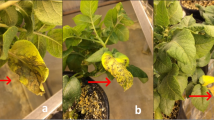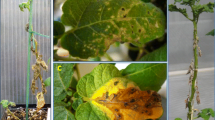Summary
We detected 384 species of plants, previously unknown as hosts of potato viruses, among 49 genera belonging to 15 families. Of these hosts, 201 had not been tested before and the remainder were shown for the first time to be indicator plants for certain viruses. Of 1094 new compatible host-virus combinations, 557 were locally, 154 systemically, and 383 locally and systemically infected, and 17% showed latent infections.
Of 165 species of 38 genera from 15 families, found for the first time to be resistant or immune, 70 had not been tested before in plant-virological experiments. Among resistant plants we found 337 new incompatible combinations, some of which are particularly important because these can be used as genetic donors (e.g.Solanum chacoense, S. simplicifolium, S. stoloniferum, S. vernei) in breeding for immunity to potato virus Y.
For the 12 viruses tested we found 3846 combinations that could be used to separate those viruses.
Zusammenfassung
In den letzten zwei Jahrzehnten befassten sich unsere Arbeiten mit neuen Wirtspflanzen für Kartoffelviren, sowohl mit resistenten als auch mit immunen und mit solchen die zur Differenzierung von Viren verwendet werden können. Untersucht wurden 400 Arten von 56 Gattungen aus 17 Familien, in Verbindung mit 12 Viren die 7 Gruppen und 2 Einzelviren repräsentierten die wir in unserer Viruskollektion fanden (Tab. 1). Unsere Versuche umfassten nur neue Wirt-Virus-Kombinationen sowie 201 Pflanzen, die bis jetzt in der Literatur über Pflanzenvirologie unbekannt waren.
Im Verlauf der Untersuchungen über neue Wirt-Virus-Kombinationen entdeckten wir 384 Arten, die als Wirte für Kartoffelviren unbekannt waren. Sie gehörten 49 Gattungen aus 15 Familien an (Tab. 2). Mehrjährige krautige und holzige Pflanzen (z.B.Crambe-, Lycium- undPentstemon-Arten) sind wichtige Komponenten in einigen neuen Kombinationen. In einigen neuenLycopersicon-Arten fanden wir eine Virusanfälligkeit, die die Reihe der Wirtspflanzen für die Kartoffelviren M und S erweiterten. Unter den Wirten für das Kartoffel-Y-Virus sind einige von besonderer Bedeutung, weil sie gegenPeronospora tabacina resistent sind (Tab. 2;Nicotiana exigua, N. goodspeedii, N. tabacum cv. Hicks Fixed A2-426). Unter den neuen Wirt-Virus-Kombinationen fanden wir eine relativ grosse Zahl latent verlaufender Infektionen. Latenz konnte bei 19 Pflanzen und 5 Viren aus 557 mit Lokalläsionen reagierenden Wirt-Virus-Verhältnissen gezeigt werden (Tab. 3), bei 107 Pflanzen und 10 Viren der 383 lokal und systemisch reagierenden Kombinationen (Tab. 4) und bei 21 Pflanzen und 5 Viren der 154 systemisch reagierenden Kombinationen (Tab. 5). Besonders wichtig ist die Latenz vonErodium-Arten,Atropa bella-donna undGeranium dissectum gegenüber Infektion mit Tabaksmosaik-Virus, Kartoffel-M-Virus, Kartoffel-S-Virus und Kartoffel-X-Virus.
In unseren Versuchen fanden wir in einigen der Wirt-Virus-Kombinationen Resistenzen und zwar in 165 Arten aus 38 Gattungen von 15 Familien (Tab. 6). 70 dieser Pflanzen waren noch nie virologisch untersucht worden. Unter diesen resistenten Pflanzen sind folgende besonders wichtig, weil sie als Ausgangsmaterial genetisch dienen können:Solanum acaule, S. cardiophyllum undS. vernei für Tabakmosaik-Virus, undS. acroscopicum, S. ajanhuiri, S. boliviense, S. brachycarpum, S. brevicaule, S. brevidens, S. chacoense, S. ehrenbergii, S. gourlayi, S. hjertingii, S. hougashii, S. infundibuliforme, S. leptophyes, S. simplicifolium, S. stoloniferum, S. vernei für Kartoffel-Y-Virus.
Die neuen Wirte und resistenten Pflanzen haben eine besondere Funktion als dichotome, reziproke und begleitende Test- oder Filterpflanzen bei der Differenzierung der Kartoffelviren. Für die in Tab. 1 genannten 12 Viren fanden wir 3846 Kombinationen, die zur Differenzierung geeignet waren (Tab. 7). Die untersuchten Pflanzen erlaubten die Differenzierung aller für Kartoffeln pathogenen Viren mit Ausnahme des Tabakrattle-Virus. Dieses Virus konnte nicht von Tabakmosaik-Virus und Kartoffel-X-Virus getrennt werden.
Résumé
Dans les 20 dernières années notre travail concernant de nouveaux hôtes des virus de la pomme de terre, ainsi que de nouvelles plantes résistantes ou immunes à ces virus ou convenant à leur séparation, a porté sur 400 espèces de 56 genres dans 17 familles de plantes et sur 12 virus appartenant à 7 groupes et 2 groupes monotypiques trouvés dans notre banque de virus (tableau 1). Nos recherches ont porté uniquement sur les nouvelles combinaisons hôte-virus inconnues jusqu'à présent dans la littérature traitant de la virologie des plantes. Au cours de notre travail nous avons expérimenté avec 201 plantes inconnues jusqu'a présent dans la littérature traitant de la virologie des plantes.
Au cours des études sur les nouvelles combinaisons hôte-virus, nous avons détecté 384 espèces de plantes de 40 genres appartenant à 15 familles précédemment inconnues en tant qu'hôtes de virus de la pomme de terre (tableau 2). Des plantes pérennes herbacées et ligneuses (par exemple: des espèces deCrambe, Lycium etPentstemon sont des éléments importants de quelques nouvelles combinaisons. En détectant la sensibilité aux virus de quelques nouvelles espèces deLycopersicon, nous avons étendu la gamme d'hôtes producteurs du PVM et PVS. Parmi les hôtes producteurs du virus Y certains sont particulièrement importants en raison de leur résistance àPeronospora tabacina (voir tableau 2:Nicotiana exigua, N. goodspeedii, N. tabacum cv. Hicks Fixed A2-426). Parmi les nouvelles combinaisons hôte-virus, nous avons découvert un nombre relativement important d'infections latentes. La latence a pu être notée entre 19 plantes et 5 virus dans les 577 relations hôte-virus localisées (tableau 3), entre 107 plantes et 10 virus dans les 383 relations localisées et systémiques (tableau 4) et entre 21 plantes et 5 virus dans les 154 relations systémiques (tableau 5). La sensibilité latente des espèces d'Erodium, d'Atropa bella-donna et deGeranium dissectum au TMV, PVM, PVS et PVX est particulièrement importante.
Dans nos expérimentations, nous avons détecté des résistances ou immunités pour quelques combinaisons hôte-virus dans le cas de 165 espèces de 38 genres dans 15 familles de plantes (tableau 6). 70 des plantes examinées n'avaient jamais été testées auparavant dans des essais virologiques. Parmi les plantes résistantes, celles qui ont un intérêt en tant que géniteurs sont particulièrement importantes: ce sontSolanum acaule, S. cardiophyllum etS. vernei pour TMV, ainsi queS. acroscopicum, S. ajanhuiri, S. boliviense, S. brachycarpum, S. brevicaule, S. brevidens, S. chacoense, S. ehrenbergii, S. gourlayi, s. hjertingii, S. hougashii, S. infundibuliforme, S. leptophyes, S. simplicifolium, S. stoloniferum, S. vernei pour le PVY.
Les nouvelles plantes hôtes, et les plantes résistantes ou immunes jouent des rôles importants dans la séparation des virus de la pomme de terre en tant que plantes différentiatrices ou plantes filtres. Pour 12 virus (tableau 1) nous avons trouvé 3846 combinaisons pouvant être utilisées pour séparer ces virus (tableau 7). Les plantes étudiées permettent de séparer tous les virus pathogènes de la pomme de terre dans de nombreuses combinaisons, sauf le virus du rattle du tabac. Le virus du rattle de tabac n'a pu être séparé du TMV et du PVX.
Similar content being viewed by others
References
Bokx, J. A. de, 1972. Viruses of potatoes and seed-potato production. Pudoc, Wageningen, Netherlands. p. 233.
Fribourg, C. E., 1980. Historia y distribución de los virus de papa en América Latina.Fitopatologia 15: 13–24.
Galindo, J., D. R. Smith & T. O. Diener, 1982. Etiology of planta macho, a viroid disease of tomato.Phytopathology 72: 49–54.
Horváth, J., 1963. Neuere Beiträge zum Vorkommen von Kartoffelviren mit besonderer Rücksicht auf Komplexinfektionen.Acta agronomica Academiae scientiarum hungaricae 14: 67–81.
Horváth, J., 1967. Separation and determination of viruses pathogenic to potatoes with special regard to potato virus Y.Acta phytopathologica Academiae scientiarum hungaricae 2: 319–360.
Horváth, J., 1976. Host ranges of viruses and virus separation. Akadémiai Doktori Értekezés (D.Sc. Thesis). Budapest and Keszthely. p. 607 (in Hungarian).
Horváth, J., 1977a. Natural occurrence of a strain of tomato mosaic virus on potato in Hungary.Potato Research 20: 347–348.
Horváth, J., 1977b. New artificial hosts and non-hosts of plant viruses and their role in the identification and separation of viruses. II. General remarks and proposals on the experimental work.Acta phytopathologica Academiae scientiarum hungaricae 12: 215–246.
Horváth, J., 1983. Gene centers of plants and the genetic basis. Veszprémi Akadémiai Bizottság Felolvasó Ülései F/4. Veszprém 1983. p. 15–25 (in Hungarian).
Horváth, J., 1984. Gene centers of potato: Sources of resistance genes and virus pathogens. In: Gy. Csaba (Ed.), A biológia aktuális problémái. Medicina Könyvkiadó, Budapest 1984. 30: 153–185 (in Hungarian).
Horváth, J. & W. H. Besada, 1980. Preservation of some plant viruses by dehydration over anhydrous calcium chloride (CaCl2).Zeitschrift für Pflanzenkrankheiten und Pflanzenschutz 87: 463–472.
Horváth, J., A. Horváth, M. Lönhardt & W. H. Besada, 1978. Natural occurrence of a strain of tomato mosaic virus on potato in Hungary.Acta phytopathologica Academiae scientiarum hungaricae 13: 299–305.
Jones, R. A. C., 1981. Oca strain of arracacha virus B from potato in Peru.Plant Disease 65: 753–754.
Jones, R. A. C., C. E. Fribourg & R. Koenig, 1983. A previously undescribed nepovirus isolated from potato in Peru.Phytopathology 73: 195–198.
Juretić, N., J. Horváth, W. H. Besada, A. Horváth & M. Lönhardt, 1977. Serological relationship of tomato mosaic virus isolated from potato to two members of tobamovirus group.Journal of the Indian Potato Association 4: 64–65.
Kenten, R. H. & R. A. C. Jones, 1979. Arracacha virus B, a second isometric virus infecting arracacha (Arracacia xanthorrhiza: Umbelliferae) in the Peruvian Andes.Annals of Applied Biology 93: 31–36.
Moreira, A., R. A. C. Jones & C. E. Fribourg, 1978. A resistance-breaking strain of potato virus X that does not cause local lesions inGomphrena globosa. Third International Congress of Plant Pathology (München, 1978). p. 56.
Salazar, L. F. & B. D. Harrison, 1977. Two previously undescribed potato viruses from South America.Nature 265: 337–338.
Wilkinson, R. E. & F. M. Blodgett, 1948.Gomphrena globosa, a useful plant for qualitative and quantitative work with potato virus X.Phytopathology 38: 28.
Author information
Authors and Affiliations
Rights and permissions
About this article
Cite this article
Horváth, J. A check-list of new host plants for identification and separation of twelve potato viruses. Potato Res 28, 71–89 (1985). https://doi.org/10.1007/BF02357572
Accepted:
Issue Date:
DOI: https://doi.org/10.1007/BF02357572




